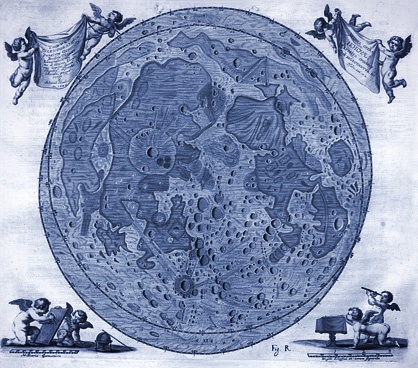Selenography – maps of the Moon

Looking at the Moon, you can recognise the spots on the surface with the naked eye, which are termed lunar maria and have always been inspiring people’s imagination. It is actually molten rock that rose to the surface during the origin of the Moon and then hardened. If looked at closer and using a telescope as an aid, you are able to make out mountains and valleys and a large amount of craters. In short: they are landscapes that give our Moon its face.
It is obvious to record these landscapes in the form of maps. In accordance with geography, which describes the physical state of the Earth and depicts this on maps, there is the »selenography« for the Moon, named after the Greek Moon Goddess Selene. Hereby, the sphere of the Moon is partitioned into longitudes and latitudes just like the Earth. And there is also a Moon equator and two poles.
The founder of lunar cartography is the Polish astronomer Johannes Hevelius (1611–1687), who studied the surface of the Moon from the rooftop of his house in Danzig in his observatory, and as a result of that, published the »Selenographia sive Lunae Descriptio« (selenography or the description of the Moon) in 1647. In it, he shows a large amount of detailed lunar maps, which have been lavishly converted into copperplate engravings and which critically tackled Galileo Galilei’s (1564–1642) earlier results. Hevelius’s work set a benchmark in an aesthetic and scientific aspect.

Many new and always more detailed lunar maps followed in the next centuries, which naturally became possible due to the improvement of optical instruments. Incidentally, because of the Moon’s synchronous rotation around the Earth, only the front part is visible to the observer from Earth, images from its reverse side could be seen only because of space probes and space missions.
Selenography is a prime example for how the human is able to converge to nature with his/hers natural need for knowledge and insight, without touching or changing it. Even though, we have cars parked on the Moon by now, and dream of a hotel on the Moon with bold thinking, the Moon will still remain as is.
